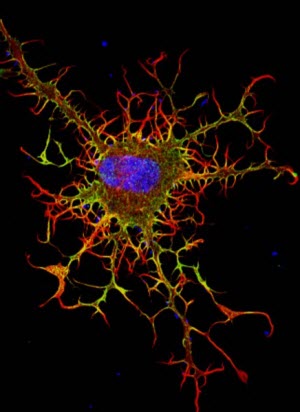A Halloween-Inspired Cell Collection
Image collection includes cell skeletons, guts and bugs, spider web-like nerve cells, cell death, zombie cells and glowing bacteria
 This is a fibroblast, a connective tissue cell that plays an important role in wound healing. Normal fibroblasts have smooth edges. In contrast, this spiky cell is missing a protein that is necessary for proper construction of the cell's skeleton. Its jagged shape makes it impossible for the cell to move normally. In addition to compromising wound healing, abnormal cell movement can lead to birth defects, faulty immune function and other health problems.Image credit: Praveen Suraneni, Stowers Institute for Medical Research, Kansas City, Mo.As Halloween approaches, the folks at NIH's National Institute of General Medical Sciences turned up some spectral images from their image gallery. They highlight some spooky-sounding—but really important—biological topics that researchers are actively investigating to spur advances in medicine. Here's one example.
This is a fibroblast, a connective tissue cell that plays an important role in wound healing. Normal fibroblasts have smooth edges. In contrast, this spiky cell is missing a protein that is necessary for proper construction of the cell's skeleton. Its jagged shape makes it impossible for the cell to move normally. In addition to compromising wound healing, abnormal cell movement can lead to birth defects, faulty immune function and other health problems.Image credit: Praveen Suraneni, Stowers Institute for Medical Research, Kansas City, Mo.As Halloween approaches, the folks at NIH's National Institute of General Medical Sciences turned up some spectral images from their image gallery. They highlight some spooky-sounding—but really important—biological topics that researchers are actively investigating to spur advances in medicine. Here's one example.
Cell Skeleton
The cell skeleton, or cytoskeleton, is the framework that gives a cell its shape, helps it move and keeps its contents organized for proper function. A cell that lacks a cytoskeleton becomes misshapen and immobile. This fibroblast, a cell that normally makes connective tissues and travels to the site of a wound to help it heal, is lacking a cytoskeleton. Researchers have associated faulty cytoskeletons and resulting abnormal cell movement with birth defects and weakened immune system functioning.
Other topics included in the image collection are guts and bugs, spider web-like nerve cells, cell death, zombie cells and glowing bacteria.
For details and to check out the other images, see http://biobeat.nigms.nih.gov/2015/10/cool-images-a-halloween-inspired-cell-collection/
